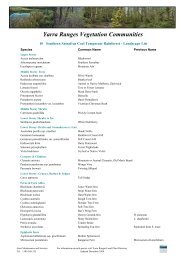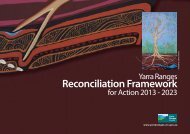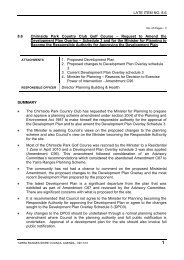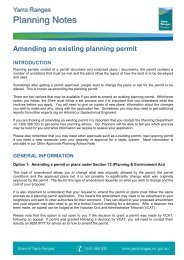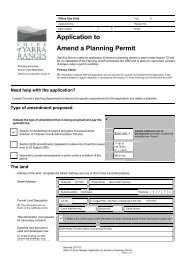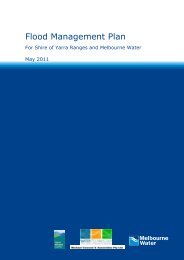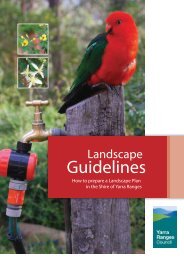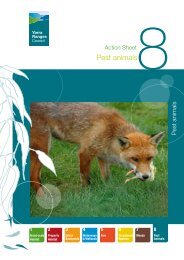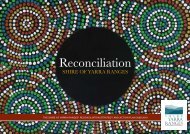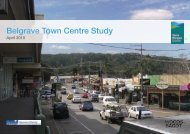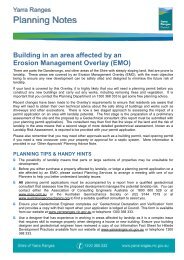Victorian Emergency Animal Welfare Plan - Shire of Yarra Ranges
Victorian Emergency Animal Welfare Plan - Shire of Yarra Ranges
Victorian Emergency Animal Welfare Plan - Shire of Yarra Ranges
Create successful ePaper yourself
Turn your PDF publications into a flip-book with our unique Google optimized e-Paper software.
<strong>Victorian</strong> <strong>Emergency</strong><strong>Animal</strong> <strong>Welfare</strong> <strong>Plan</strong>Department <strong>of</strong> Primary IndustriesDepartment <strong>of</strong> Sustainability and Environment
State <strong>Emergency</strong> <strong>Animal</strong> <strong>Welfare</strong> ContactsDepartment <strong>of</strong>Primary IndustriesManager <strong>Animal</strong> HealthField Services,State <strong>Emergency</strong> <strong>Animal</strong><strong>Welfare</strong> Coordinator136 186 www.dpi.vic.gov.auDepartment <strong>of</strong>Sustainability and EnvironmentStatewide Program Leader -Biodiversity136 186 www.dse.vic.gov.auIf you would like to receive this information/publication inan accessible format (such as large print or audio) please callthe Customer Service Centre on 136 186, TTY 1800 122 969,or email customer.service@dpi.vic.gov.au.Published by the Department <strong>of</strong> Primary IndustriesDepartment <strong>of</strong> Primary Industries, September 2011.© The State <strong>of</strong> Victoria 2011.This publication is copyright. No part may be reproduced by any processexcept in accordance with the provisions <strong>of</strong> the Copyright Act 1968.Authorised by the Department <strong>of</strong> Primary Industries, 1 Spring Street, Melbourne 3000.Version 1.0 27 September 2011ISBN 978-1-74264-941-2 (print)ISBN 978-1-74264-942-9 (online)DisclaimerThis publication may be <strong>of</strong> assistance to you but the State <strong>of</strong> Victoria and its employeesdo not guarantee that the publication is without flaw <strong>of</strong> any kind or is wholly appropriatefor your particular purposes and therefore disclaims all liability for any error, loss or otherconsequence which may arise from you relying on any information in this publication.For more information about DPI go to www.dpi.vic.gov.auor phone the Customer Service Centre on 136 186.ii<strong>Victorian</strong> <strong>Emergency</strong> <strong>Animal</strong> <strong>Welfare</strong> <strong>Plan</strong>
ContentsDefinitions 1Acronyms 4Foreword 5Executive summary 61.0 Introduction 72.0 Purpose and scope 83.0 Guiding principles 94.0 Authority and governance 105.0 Emergencies impacting animal welfare 116.0 <strong>Animal</strong> <strong>Welfare</strong> Services 136.1 <strong>Plan</strong>ning for animals in the event <strong>of</strong> an emergency 136.2 Identification <strong>of</strong> affected animals 146.3 Management <strong>of</strong> displaced animals (including evacuated animals) 146.4 <strong>Animal</strong> welfare assessment, veterinary treatment, humane destruction, salvage slaughter and disposal 156.5 Provision <strong>of</strong> emergency pet food, livestock fodder and water 176.6 Coordination <strong>of</strong> donations and <strong>of</strong>fers <strong>of</strong> assistance 176.7 Long term recovery needs 187.0 Roles and responsibilities 197.1 Persons in charge <strong>of</strong> animals 197.2 <strong>Animal</strong> welfare organisations 197.3 Australian Veterinary Association (Victoria Division) 207.4 Country Fire Authority 217.5 Department <strong>of</strong> Human Services 217.6 Department <strong>of</strong> Primary Industries 227.7 Department <strong>of</strong> Sustainability and Environment 237.8 Local Government 247.9 Royal Society for Prevention <strong>of</strong> Cruelty to <strong>Animal</strong>s (<strong>Victorian</strong> Branch) 267.10 Victoria Police 267.11 <strong>Victorian</strong> State <strong>Emergency</strong> Service 277.12 Wildlife shelters and carers 27<strong>Victorian</strong> <strong>Emergency</strong> <strong>Animal</strong> <strong>Welfare</strong> <strong>Plan</strong>iii
8.0 Operating principles 288.1 Incident management systems 288.2 State <strong>Emergency</strong> <strong>Animal</strong> <strong>Welfare</strong> Coordinator 288.3 Preparedness and response 298.4 Rapid impact assessment 308.5 Responding to the needs <strong>of</strong> companion animals, livestock and wildlife 308.6 Processes for requesting supplementary resources 308.7 Access to impacted areas 318.8 Information collection and sharing 318.9 Contacts and communications 318.10 Training and exercising 318.11 Evaluation and review 319.0 Appendices 32Appendix 1: Further information 32Appendix 2: Generic organisational structure 35Appendix 3: Contacts 36iv<strong>Victorian</strong> <strong>Emergency</strong> <strong>Animal</strong> <strong>Welfare</strong> <strong>Plan</strong>
DefinitionsAgency<strong>Animal</strong><strong>Animal</strong> welfareBiosecurityCommandCompanion animalControlControl agencyCoordinationA Government agency, including Commonwealth, State or local government authority.Companion animals, livestock including horses and poultry, wildlife, birds, and fish [Protection<strong>of</strong> Cruelty to <strong>Animal</strong>s Act, 1986].How an animal is coping with the conditions in which it lives. An animal is in a good state <strong>of</strong>welfare if (as indicated by scientific evidence) it is healthy, comfortable, well nourished, safe,able to express innate behaviour, and if it is not suffering from unpleasant states such as pain,fear, and distress. Good animal welfare requires disease prevention and veterinary treatment,appropriate shelter, management, nutrition, humane handling and humane slaughter/killing.<strong>Animal</strong> welfare refers to the state <strong>of</strong> the animal; the treatment that an animal receives is coveredby other terms such as animal care, animal husbandry, and humane treatment. [OIE May 2008 -International Office <strong>of</strong> <strong>Animal</strong> Health].The protection <strong>of</strong> the economy, the environment, social amenity or human health from negativeimpacts associated with the entry, establishment or spread <strong>of</strong> animal or plant pests and disease,or invasive plant and animal species.The direction <strong>of</strong> personnel and resources <strong>of</strong> an agency in the performance <strong>of</strong> that organisation’srole and tasks. Authority to command is established in legislation or by agreement within anagency (<strong>Emergency</strong> Management Manual <strong>of</strong> Victoria,{EMMV, 2010}).Any non-human vertebrate animal kept for the purpose <strong>of</strong> companionship, recreation, protectionor work with the following exclusions:a) animals kept exclusively for agricultural production on premises legally zoned or licensed foragricultural activities,b) horses kept solely for racing purposes (under Racing Act provisions), orc) any class, group, type or species declared by Governor in Council as being exempt.(<strong>Victorian</strong> Parliament Social Development Committee May 1989‘ ‘Inquiry into the Role and<strong>Welfare</strong> <strong>of</strong> Companion <strong>Animal</strong>s in Society’).The overall direction <strong>of</strong> response activities in an emergency. Authority for control is establishedin legislation or in an emergency response plan, and carries with it the responsibility for taskingother agencies in accordance with the needs <strong>of</strong> the situation. Control relates to situations andoperates horizontally across agencies.An agency nominated to control the response activities for a specified type <strong>of</strong> emergency (EMMV,2010).Co-ordination involves the bringing together <strong>of</strong> agencies and resources to ensure effectiveresponse to and recovery from emergencies. The main functions <strong>of</strong> co-ordination are:• In relation to response, ensuring that effective control has been established and maintained,and• The systematic acquisition and allocation <strong>of</strong> resources in accordance with the requirementsimposed by emergencies.Co-ordination operates throughout the management <strong>of</strong> response and recovery activities. VictoriaPolice is the co-ordination agency for response and the Department <strong>of</strong> Human Services is the coordinationagency for recovery (EMMV, 2010).<strong>Victorian</strong> <strong>Emergency</strong> <strong>Animal</strong> <strong>Welfare</strong> <strong>Plan</strong>1
<strong>Emergency</strong><strong>Emergency</strong> <strong>Animal</strong><strong>Welfare</strong> Coordinator<strong>Emergency</strong> Relief<strong>Emergency</strong> ReliefCentre<strong>Emergency</strong> ResponseCoordinatorEvacuationFodderLivestockOrganisationPersons in charge<strong>of</strong> animalsRecoverySalvage slaughterState <strong>Emergency</strong><strong>Animal</strong> <strong>Welfare</strong>CoordinatorAn emergency due to the actual or imminent occurrence <strong>of</strong> an event which in any way endangersor threatens to endanger the safety or health <strong>of</strong> any person in Victoria or which destroys ordamages, or threatens to destroy or damage, any property in Victoria, or endangers or threatensto endanger the environment or an element <strong>of</strong> the environment in Victoria (EMMV, 2010).Refer to State <strong>Emergency</strong> <strong>Animal</strong> <strong>Welfare</strong> Coordinator.The provision <strong>of</strong> life support and essential needs to persons affected by an emergency (EMMV,2010).A building or place established to provide life support and essential needs to persons affectedby an emergency (including evacuees). <strong>Emergency</strong> relief centres are established on a temporarybasis to cope with the immediate needs <strong>of</strong> those affected during the initial response to theemergency. They do not imply any longer-term use <strong>of</strong> facilities as a location for recovery services(EMMV, 2010).A member <strong>of</strong> the Victoria Police appointed as state, regional, municipal or field emergencyresponse co-ordinator, whose role is to co-ordinate the response to an emergency. Included inthis role is arranging for the provision <strong>of</strong> resources requested by control and support agencies.A Municipal <strong>Emergency</strong> Response Coordinator (MERC) will advise the Regional <strong>Emergency</strong>Response Coordinator <strong>of</strong> the potential need for supplementary resources. The Regional <strong>Emergency</strong>Response Coordinator (RERC) will arrange to provide regional resources requested by a MERC, orif necessary, elevate the resource request to the State <strong>Emergency</strong> Response Coordinator (SERC)(EMMV, 2010).‘The planned relocation <strong>of</strong> persons from dangerous or potentially dangerous areas to safer areasand eventual return’. ‘Evacuation may be undertaken…on their own volition and independent<strong>of</strong> any advice, or it may be after an assessment <strong>of</strong> information provided by a control agency’.(Extract from the EMMV, Part 3 - State <strong>Emergency</strong> Response <strong>Plan</strong> - Community Safety –Evacuation).Feed for livestock such as hay, or pre-prepared feedstuffs designed specifically for livestock.(a) Any animal kept for the purposes <strong>of</strong> primary production, including cattle, sheep, pigs,poultry, ratites, buffalo, camels, alpacas, goats and deer; or (b) horses, including where used forrecreation; or (c) any animals prescribed as livestock (Livestock Management Act, 2010).Any non-government or not for pr<strong>of</strong>it entity, company or authority.A person who is the owner or has the animal in their possession or custody, or under theperson’s care, control or supervision: and any employee or agent <strong>of</strong> the owner <strong>of</strong> the animal.The assisting <strong>of</strong> persons and communities affected by emergencies to achieve a proper andeffective level <strong>of</strong> functioning (EMMV, 2010).The processing <strong>of</strong> animals through an abattoir. Livestock impacted by an emergency, suitablefor salvage slaughter are those that do not show signs <strong>of</strong> distress and are fit enough to betransported.A role established by DPI when an emergency requires statewide coordination <strong>of</strong> animal welfareservice arrangements across multiple agencies and organisations. The SEAWC manages the State<strong>Emergency</strong> <strong>Animal</strong> <strong>Welfare</strong> Unit when activated.2 <strong>Victorian</strong> <strong>Emergency</strong> <strong>Animal</strong> <strong>Welfare</strong> <strong>Plan</strong>
State <strong>Emergency</strong><strong>Animal</strong> <strong>Welfare</strong> UnitSupport agencyA unit established by DPI to assist in the state-wide coordination <strong>of</strong> animal welfare services andresources. The unit will operate within a DPI state level incident management structure (when inplace) or that <strong>of</strong> a control agency.An agency which provides services, personnel, or material to support or assist a control agencyor affected persons.DPI is the primary Agency for companion animal and livestock welfare support services.Triage<strong>Victorian</strong> <strong>Emergency</strong><strong>Animal</strong> <strong>Welfare</strong>CommitteeWildlifeDSE is the primary Agency for wildlife welfare support services (EMMV, 2010).The process <strong>of</strong> determining the priority <strong>of</strong> veterinary treatment based on the severity <strong>of</strong> ananimal’s condition. This rations veterinary treatment efficiently when resources are insufficientfor all to be treated immediately.A consultative forum that provides ongoing leadership and oversight in the development andreview <strong>of</strong> plans and policies relating to emergency animal welfare management. Membershipincludes DPI (chair), DSE, RSPCA, MAV, local government and AVAAny vertebrate animal indigenous to Australia, some non-indigenous vertebrates (deer and gamebirds declared to be wildlife under the Wildlife Act, 1975), any terrestrial invertebrates listed asthreatened under the Flora and Fauna Guarantee Act, 1988, and does not include fish within themeaning <strong>of</strong> the Fisheries Act, 1995.<strong>Victorian</strong> <strong>Emergency</strong> <strong>Animal</strong> <strong>Welfare</strong> <strong>Plan</strong>3
AcronymsAVACFADHSDPIDSEEMMVICIMTIMSLGOMAVMECCMERCMEROMFBPASAustralian Veterinary Association (<strong>Victorian</strong> Division)Country Fire AuthorityDepartment <strong>of</strong> Human ServicesDepartment <strong>of</strong> Primary IndustriesDepartment <strong>of</strong> Sustainability and Environment<strong>Emergency</strong> Management Manual <strong>of</strong> VictoriaIncident ControllerIncident Management TeamIncident Management SystemLocal Government OfficerMunicipal Association <strong>of</strong> VictoriaMunicipal <strong>Emergency</strong> Co-ordination CentreMunicipal <strong>Emergency</strong> Response Co-ordinatorMunicipal <strong>Emergency</strong> Resource OfficerMetropolitan Fire BrigadePet <strong>Animal</strong> ShelterPOCTA Prevention <strong>of</strong> Cruelty to <strong>Animal</strong>s Act, 1986PVRSPCASEAWCSCCSERCCSEROSESSIGsVEAWCVicPolVFFParks VictoriaRoyal Society for the Prevention <strong>of</strong> Cruelty to <strong>Animal</strong>sState <strong>Emergency</strong> <strong>Animal</strong> <strong>Welfare</strong> CoordinatorState Control CentreState <strong>Emergency</strong> Response Co-ordination CentreState <strong>Emergency</strong> Response Officer <strong>of</strong> Victoria PoliceState <strong>Emergency</strong> ServiceSpecial Interest Groups<strong>Victorian</strong> <strong>Emergency</strong> <strong>Animal</strong> <strong>Welfare</strong> CommitteeVictoria Police<strong>Victorian</strong> Farmers Federation4 <strong>Victorian</strong> <strong>Emergency</strong> <strong>Animal</strong> <strong>Welfare</strong> <strong>Plan</strong>
ForewordVictoria is faced with many different types <strong>of</strong> emergencies and threats that impact on animals, whether they becompanion animals, livestock or wildlife in bushland, rural or urban settings.<strong>Animal</strong> owners and carers have the ultimate “duty <strong>of</strong> care” to plan and provide for the needs <strong>of</strong> animals in their charge.However, as was witnessed during the devastating fires <strong>of</strong> 2009, government and non government organisations andgroups share this responsibility and together have enormous capacity and incredible willingness to assist affected peopleand attend to the welfare needs <strong>of</strong> impacted animals.This provides both a challenge and opportunity. A well coordinated effort ensures needs are met in a timely, safe,efficient and effective manner. A lack <strong>of</strong> coordination can further add to stress, frustration and suffering.The <strong>Victorian</strong> <strong>Emergency</strong> <strong>Animal</strong> <strong>Welfare</strong> <strong>Plan</strong> (the <strong>Plan</strong>) sets out coordination arrangements for emergency animal welfaremanagement in Victoria including the scope <strong>of</strong> activities, responsibilities and interactions, and addresses a key action in“Implementing the Government’s Response to the 2009 <strong>Victorian</strong> Bushfires Royal Commission May 2011” .The development <strong>of</strong> the <strong>Plan</strong> was achieved through widespread consultation between the Department <strong>of</strong> PrimaryIndustries and Department <strong>of</strong> Sustainability and Environment, as primary agencies in emergency animal welfare supportservices, and a range <strong>of</strong> stakeholders. This includes significant contributions from the following organisations that,through their experiences and the lessons from Black Saturday, have remained committed to improving animal welfaremanagement during emergencies.• Australian Veterinary Association, <strong>Victorian</strong> Division• City <strong>of</strong> Whittlesea• Mitchell <strong>Shire</strong> Council• Municipal Association <strong>of</strong> Victoria• Nillumbik <strong>Shire</strong> Council• Royal Society for the Prevention <strong>of</strong> Cruelty to <strong>Animal</strong>s, <strong>Victorian</strong> Branch• <strong>Yarra</strong> <strong>Ranges</strong> <strong>Shire</strong> CouncilJeff RosewarneSecretary, Department <strong>of</strong> Primary IndustriesGreg WilsonSecretary, Department <strong>of</strong> Sustainability and Environment<strong>Victorian</strong> <strong>Emergency</strong> <strong>Animal</strong> <strong>Welfare</strong> <strong>Plan</strong>5
Executive summary<strong>Animal</strong>s play a significant role in the lives <strong>of</strong> <strong>Victorian</strong>s. <strong>Victorian</strong>s own an estimated 8,937,000 pets 1 including dogs,cats, birds and horses. In addition there are more than 20 million cattle and sheep, 0.6 million pigs and 25 millionpoultry on over 20,000 farms 2 . While it is difficult to quantify wildlife populations in a similar manner, human interestin the welfare <strong>of</strong> native animals can be reflected in the 340 wildlife shelters and 363 foster carers currently authorized torehabilitate wildlife in Victoria, and the 7,000 native animals which are treated in <strong>Victorian</strong> shelters each year.Many types <strong>of</strong> emergencies in Victoria inevitably affect animals. Furthermore, recent disasters in Australia and overseashighlighted that bonds between people and animals strongly influence decision making in times <strong>of</strong> crisis. The lack <strong>of</strong>adequate planning for the management <strong>of</strong> animals and their welfare in emergencies <strong>of</strong>ten results in poor, last minutedecisions with dangerous or fatal consequences for animals and their owners or carers.Before, during and after an emergency, persons in charge <strong>of</strong> animals retain the ultimate ‘duty <strong>of</strong> care’ to provide for theneeds <strong>of</strong> animals in their charge. In the event <strong>of</strong> an emergency, Government acknowledges the supporting role it can playin helping owners or carers meet their requirements.Victoria’s emergency management arrangements define the Department <strong>of</strong> Primary Industries as the primary agency forlivestock and companion animal welfare support services during an emergency response. The Department <strong>of</strong> Sustainabilityand Environment is the primary agency for wildlife welfare support services. As the closest level <strong>of</strong> government to theaffected community, local government also has a key role in supporting emergency animal welfare activities. Numerousnon-government organisations assist in the management <strong>of</strong> animal welfare, with the RSPCA, Australian VeterinaryAssociation and the <strong>Victorian</strong> Farmers Federation having special capacities to assist.This <strong>Victorian</strong> <strong>Emergency</strong> <strong>Animal</strong> <strong>Welfare</strong> <strong>Plan</strong> (the <strong>Plan</strong>) provides principles and policy for use in emergency planning,response and recovery phases. The framework provided by this <strong>Plan</strong> can be used for management <strong>of</strong> animal welfareduring any emergency but also to inform the development <strong>of</strong> specific operational plans by agencies where legislativerequirements are explained and formally linked into the State emergency arrangements.The <strong>Plan</strong> was developed following extensive consultation with many emergency management and animal welfarestakeholders including the <strong>Victorian</strong> <strong>Emergency</strong> <strong>Animal</strong> <strong>Welfare</strong> Committee. It defines roles and responsibilities <strong>of</strong>agencies and organisations and their operational interactions with the overarching objectives to:• Contribute to enhanced public safety and community resilience through effective planning and management <strong>of</strong> animalsin emergencies, and• Ensure animals are better considered and protected from suffering during and immediately following emergencies.1 Australian Companion <strong>Animal</strong> Council, 2007 statistics2 ABS 2005/066 <strong>Victorian</strong> <strong>Emergency</strong> <strong>Animal</strong> <strong>Welfare</strong> <strong>Plan</strong>
1.0 IntroductionWhile the responsibility for the welfare <strong>of</strong> an animal remains with the person or persons in charge <strong>of</strong> that animal, manydifferent agencies and organisations are available to assist during emergencies in Victoria. With so many differentagencies and organisations assisting during an incident, whether voluntary or permanently staffed, their activities needto be coordinated to avoid duplication <strong>of</strong> effort or conflict, and ensure efficient and effective emergency planning andmanagement <strong>of</strong> relief and recovery activities relating to animal welfare.In February 2009, Victoria experienced widespread bushfires, which caused major destruction in rural areas, bushlandand townships. Government departments and agencies, private businesses and community organisations participatedin the largest coordinated emergency response, relief and recovery operation in the State’s history. The lack <strong>of</strong> aspecific plan for the coordination <strong>of</strong> the significant efforts <strong>of</strong> animal welfare agencies, organisations, volunteers andindividuals, coupled with the scale <strong>of</strong> the event, led to confusion, duplication <strong>of</strong> resources and lack <strong>of</strong> targeted activityin some areas.The Bushfires Royal Commission recognised the bonds people form with animals and the significant impact thesebonds can have on people’s decision making, and ultimately their safety during emergencies. The Commission notedin its findings:“There were also a small number <strong>of</strong> cases in which people died after refusing to leave without their pets andanimals or delaying their departure for too long because <strong>of</strong> concern for their animals. Evidence demonstratesthat the strong ties people have with their homes and their animals have a big impact on their decisionmaking.”(Extract from the 2009 <strong>Victorian</strong> Bushfires Royal Commission: Fire Preparation, Response and Recovery,Final Report Volume II) Further, the Commission noted “There does not appear to be a coordinated approach toanimal welfare during relief operations. Improving agency coordination would help to provide more effective reliefto all animals regardless <strong>of</strong> whether they are wildlife, stock, companion animals or pets. There is a good argumentto address the welfare <strong>of</strong> all animals holistically in the <strong>Emergency</strong> Management Manual Victoria”. (Bushfires RoyalCommission- final report - Vol 2, Ch 8 pp 345).“Implementing Government’s Response to the 2009 <strong>Victorian</strong> Bushfires Royal Commission May 2011” was tabled inParliament and provided several actions for Government related to animal welfare in emergencies. As administrator <strong>of</strong>the Prevention <strong>of</strong> Cruelty to <strong>Animal</strong>s Act 1986 (POCTA), DPI was asked to review the draft <strong>Victorian</strong> <strong>Emergency</strong> <strong>Animal</strong><strong>Welfare</strong> <strong>Plan</strong> and did so in consultation with agencies and organisations on the <strong>Victorian</strong> <strong>Emergency</strong> <strong>Animal</strong> <strong>Welfare</strong>Committee which included the Department <strong>of</strong> Sustainability and Environment (DSE), Municipal Association <strong>of</strong> Victoria(MAV), the Royal Society for the Prevention <strong>of</strong> Cruelty to <strong>Animal</strong>s (RSPCA), and the Australian Veterinary Association<strong>Victorian</strong> Division (AVA). Victoria’s 79 councils were also invited to participate in the review which looked at the roles,responsibilities and formal arrangements between the various stakeholders for the delivery <strong>of</strong> all emergency response,relief and recovery activities in relation to animal welfare.<strong>Victorian</strong> <strong>Emergency</strong> <strong>Animal</strong> <strong>Welfare</strong> <strong>Plan</strong>7
2.0 Purpose and scopeThe purpose <strong>of</strong> this document is to provide the <strong>Victorian</strong> community and emergency services with a <strong>Plan</strong> thatintegrates existing, everyday legislative requirements for animal welfare with the State’s formal emergency managementarrangements, to achieve efficient and effective management <strong>of</strong> animals, and coordination <strong>of</strong> animal welfare supportservices before, during and after an emergency event. The <strong>Plan</strong> describes:• The planning requirements for animal welfare support services in emergency preparedness, response, reliefand recovery,• The roles and responsibilities <strong>of</strong> agencies, organisations, owners and carers that have a role in planning for andproviding emergency animal welfare support services, and• Operating arrangements during an emergency for animal welfare agencies and organisations, emergency serviceagencies and animal owners and carers.The scope <strong>of</strong> this <strong>Plan</strong> is to provide a coordinated approach to the management <strong>of</strong> animal welfare impacts to companionanimals, livestock, and wildlife, as a direct result <strong>of</strong> an emergency incident in Victoria. This <strong>Plan</strong> provides a frameworkduring any emergency that impacts animal welfare, to clarify responsibilities and highlight existing emergency responseplans and procedures. This <strong>Plan</strong> does not replace specific agency operational emergency management plans, rather itprovides for the overarching coordination between agencies and organisations.The <strong>Plan</strong> provides for the new role <strong>of</strong> State <strong>Emergency</strong> <strong>Animal</strong> <strong>Welfare</strong> Coordinator (SEAWC). This role is notionallyassigned to the Department <strong>of</strong> Primary Industries (DPI) State Manager, <strong>Animal</strong> Health Field Services as the initial contactperson for the state wide coordination <strong>of</strong> animal welfare activities. The SEAWC may convene a multi-agency advisorygroup, where necessary during an emergency, to assist with state wide coordination <strong>of</strong> animal welfare arrangements.Decisions regarding implementation <strong>of</strong> specific operational plans reside with respective agencies and organisations.8 <strong>Victorian</strong> <strong>Emergency</strong> <strong>Animal</strong> <strong>Welfare</strong> <strong>Plan</strong>
3.0 Guiding principlesIn implementing this <strong>Plan</strong> the following principles apply:• The safety and welfare <strong>of</strong> all people is the overarching priority at all times.• The responsibility for the welfare <strong>of</strong> animals at all times remains with the person in charge <strong>of</strong> an animal.• <strong>Emergency</strong> arrangements for animal welfare do not override normal legislative functions however the givencircumstances may call for discretion in managing compliance given potential risks to human life or other practicallimitations perceived to be present during the emergency.• This <strong>Plan</strong> does not replace animal welfare arrangements described in existing emergency plans (ie. AUSVETPLAN andplans relating to cetacean entanglements or strandings and marine pollution).• Organisations may strive for higher animal welfare standards than outlined in this document.• While arrangements described in this <strong>Plan</strong> are typical, it is recognised that a Control Agency may recommendadditional or alternative actions at the incident, regional or state level to meet the needs <strong>of</strong> the particular emergency.• As the capacity and capability <strong>of</strong> agencies and organisations in animal welfare services will change, an adaptive,flexible and whole <strong>of</strong> government approach to arrangements is essential to ensuring the objectives <strong>of</strong> this <strong>Plan</strong>are met.<strong>Victorian</strong> <strong>Emergency</strong> <strong>Animal</strong> <strong>Welfare</strong> <strong>Plan</strong>9
4.0 Authority and governanceThe <strong>Emergency</strong> Management Act, 1986 provides for the organisation <strong>of</strong> emergency management in Victoria. The <strong>Emergency</strong>Management Manual Victoria (EMMV) contains the state’s principal emergency policy and planning documents andincludes the State <strong>Emergency</strong> Response <strong>Plan</strong> and the State <strong>Emergency</strong> Relief and Recovery <strong>Plan</strong>.The custodian <strong>of</strong> this <strong>Plan</strong> is the Department <strong>of</strong> Primary Industries and it is intended to be a reference for all otheragencies, organisations, groups and individuals with responsibility for animal welfare during emergencies.This <strong>Plan</strong> is a reference for use in the development <strong>of</strong> Municipal <strong>Emergency</strong> Management <strong>Plan</strong>s (MEM<strong>Plan</strong>s) and Domestic<strong>Animal</strong> Management <strong>Plan</strong>s and provides guidance to other non-government organisation plans with respect to animalwelfare arrangements in Victoria.Legislative linksThis <strong>Plan</strong> should be read in conjunction with relevant legislation and plans that may identify further strategies,arrangements and resources that assist planning and delivery <strong>of</strong> animal welfare services following an emergency event inVictoria. Relevant documents include but are not limited to:• <strong>Emergency</strong> Management Act, 1986--<strong>Emergency</strong> Management Manual Victoria--State <strong>Emergency</strong> Relief and Recovery <strong>Plan</strong>--Department <strong>of</strong> Human Services Relief Handbook--Local Government Municipal <strong>Emergency</strong> Management <strong>Plan</strong>s• Prevention <strong>of</strong> Cruelty to <strong>Animal</strong>s Act ,1986 (POCTA)--Underpinning Codes <strong>of</strong> Accepted Practice for the <strong>Welfare</strong> <strong>of</strong> <strong>Animal</strong>s (refer to Appendix 1 for further information)• Domestic <strong>Animal</strong>s Act, 1994• Livestock Management Act, 2010• Impounding <strong>of</strong> Livestock Act, 1994• Wildlife Act, 1975• Flora and Fauna Guarantee Act, 1988• Occupational Health and Safety (OH&S) Act, 200410 <strong>Victorian</strong> <strong>Emergency</strong> <strong>Animal</strong> <strong>Welfare</strong> <strong>Plan</strong>
5.0 Emergencies impactinganimal welfarePart 7 <strong>of</strong> the EMMV lists a number <strong>of</strong> specific animal welfare emergencies, for example emergency animal disease eventsand cetacean emergencies. In these cases, the EMMV assigns responsibility for managing an emergency, and henceanimal welfare, to specific agencies. In other emergencies listed under the EMMV, such as bushfire, floods and marinepollution events, impacts on animal welfare may be incidental to the broader emergency. If animals are impacted duringthese emergencies, the EMMV details that:• DPI is the primary agency for livestock and companion animal welfare support services.• DSE is the primary agency for wildlife welfare support services.As primary agencies with animal welfare support responsibilities, DPI and DSE have a role in establishing links with otheragencies and organisations with emergency responsibilities as well as those organisations involved in the management<strong>of</strong> animal welfare to ensure resources and capability are directed in the most efficient manner towards relief activities.This coordinated effort might include others such as Parks Victoria (PV), local government, RSPCA, local veterinarians(including the AVA), the VFF, wildlife rescue and rehabilitation groups and other volunteer groups involved with assistingrelief and recovery <strong>of</strong> animals after emergencies.Table 1 describes the emergencies listed under the EMMV that are likely to have animal welfare implications, the relevantcontrol agency and primary state government animal welfare support agency as well as associated plans and proceduresthat describe specific operational arrangements. The table does not list the numerous other support agencies ororganisations that will have a role in the delivery <strong>of</strong> specific animal welfare services.If an emergency that involves animal welfare occurs, and specific plans and procedures are not defined, this <strong>Plan</strong> (orother relevant plans) may be used to guide an appropriate response.Appendix 2 provides a generic example <strong>of</strong> the organisational structure that could be developed in the case <strong>of</strong> a largescale emergency response that impacts on livestock, companion animals and/or wildlife where both DPI and DSE aresupport agencies.<strong>Victorian</strong> <strong>Emergency</strong> <strong>Animal</strong> <strong>Welfare</strong> <strong>Plan</strong>11
Table 1: Specific operational plans for emergencies that impact on animal welfare<strong>Emergency</strong> Control Agency Primary Agencyfor <strong>Animal</strong><strong>Welfare</strong> SupportStorm (includinghail), Flood,Tsunami,EarthquakeFireCetacean (whaleand dolphin)entanglements orstrandingsMarine pollutionemergenciesSESCFA / DSE / MFB(depending onlocation)DPI – Companion<strong>Animal</strong>s andLivestockDSE - WildlifeDPI – Companion<strong>Animal</strong>s andLivestockDSE – WildlifeRelevant <strong>Animal</strong> <strong>Welfare</strong> <strong>Plan</strong>s and Procedures• <strong>Victorian</strong> <strong>Emergency</strong> <strong>Animal</strong> <strong>Welfare</strong> <strong>Plan</strong>Bushfire on public land:• Working with fire agencies at Bushfires: Protocols forVolunteers Involved in Wildlife Rescue Operations, DSE/CFA, October 2010• Bushfire Wildlife Rescue Initiative Role Statements andReporting Relationships• <strong>Victorian</strong> <strong>Emergency</strong> <strong>Animal</strong> <strong>Welfare</strong> <strong>Plan</strong>DSE DPI • <strong>Victorian</strong> Cetacean Contingency <strong>Plan</strong>Department <strong>of</strong>TransportDSE• <strong>Victorian</strong> Cetacean <strong>Emergency</strong> <strong>Plan</strong> (draft)• Readiness and Response <strong>Plan</strong> for Large WhaleEntanglement in Victoria, DSE, (Jan 2008) (draft)• Wildlife Response <strong>Plan</strong> for Marine Pollution Emergencies(DSE, 2007)<strong>Emergency</strong> animaldiseaseTransportIncidents(involvinglivestock)Hazardous spillsor leaks (gasleaks, chemical,oil, radioactive orbiological)DroughtDPIGas, Chemical, Oil(CFA,MFB)Biological andradioactive (Dept<strong>of</strong> Health)DPI – Companion<strong>Animal</strong>s andLivestockDSE - WildlifeDPIDPI – Companion<strong>Animal</strong>s andLivestockDSE - WildlifeDPI – Companion<strong>Animal</strong>s andLivestockDSE - Wildlife• AUSVETPLAN• Operational Procedures Manual: Livestock welfare andmanagement• <strong>Victorian</strong> <strong>Emergency</strong> <strong>Animal</strong> <strong>Welfare</strong> <strong>Plan</strong>• Livestock Transport Incident Response Policy• DPI Standard Operating Procedure: Transport AccidentsInvolving Livestock in Transit• <strong>Victorian</strong> <strong>Emergency</strong> <strong>Animal</strong> <strong>Welfare</strong> <strong>Plan</strong>• <strong>Victorian</strong> <strong>Emergency</strong> <strong>Animal</strong> <strong>Welfare</strong> <strong>Plan</strong>• <strong>Victorian</strong> <strong>Emergency</strong> <strong>Animal</strong> <strong>Welfare</strong> <strong>Plan</strong>12 <strong>Victorian</strong> <strong>Emergency</strong> <strong>Animal</strong> <strong>Welfare</strong> <strong>Plan</strong>
6.0 <strong>Animal</strong> <strong>Welfare</strong> ServicesIn the event <strong>of</strong> an emergency, animal welfare may be compromised if management arrangements are not effectively inplace. Companion animals, livestock and wildlife impacted by emergencies may need containment, food, water, veterinarytreatment or humane destruction and burial. While healthy wildlife should be left in their natural habitat, companionanimals and livestock might require temporary shelter or holding facilities.Before, during and after an emergency, persons in charge <strong>of</strong> animals retain the ultimate ‘duty <strong>of</strong> care’ to provide for theirneeds. In the event <strong>of</strong> an emergency, a number <strong>of</strong> government agencies and non-government organisations contributeto improved animal welfare outcomes by providing or facilitating a range <strong>of</strong> animal welfare support services. This <strong>Plan</strong>defines “animal welfare support services” as including, but not limited to, the following activities:• <strong>Plan</strong>ning for animals in the event <strong>of</strong> an emergency,• Identification <strong>of</strong> affected animals,• Management <strong>of</strong> displaced animals (including evacuated animals),• <strong>Animal</strong> welfare assessment, veterinary treatment, humane destruction, salvage slaughter and disposal,• Provision <strong>of</strong> emergency pet food, livestock fodder and water,• Coordination <strong>of</strong> donations and <strong>of</strong>fers <strong>of</strong> assistance, and• Longer term recovery needs.The section below provides further information on animal welfare services and the role <strong>of</strong> primary and secondary supportagencies and organisations in providing these services.6.1 <strong>Plan</strong>ning for animals in the event <strong>of</strong> an emergency<strong>Plan</strong>ning prior to an emergency event ensures best practice is achieved. As defined in POCTA, the person in charge <strong>of</strong>an animal has primary responsibility (duty <strong>of</strong> care) to ensure it is protected from unnecessary pain or suffering.For those in charge <strong>of</strong> animals, including companion animal owners, livestock owners and wildlife shelter operatorsand foster carers, planning for emergencies is critical. Personal safety plans and household or property plans shouldinclude contingencies for animals that will either remain on the property or be evacuated during an emergency (Refer toAppendix 1 for further sources <strong>of</strong> information).It is acknowledged that in the event <strong>of</strong> an emergency, standards <strong>of</strong> animal care may be compromised. Those in charge <strong>of</strong>animals may have to evacuate quickly, potentially leaving animals behind, and may be restricted in their ability to carefor animals.For this reason, the underpinning principle in addressing animal welfare in an emergency is for those in charge totake pre-emptive action by planning for animal needs and leaving early so that welfare problems can be avoided orminimised.For agencies and organisations involved in the provision <strong>of</strong> animal welfare services, planning should include:• Developing and reviewing plans and procedures,• Conducting training and exercises,• Ensuring contacts are current across government and non government agencies and organisations, and• Contributing to relevant committees and forums.DPI and DSE ensure consistency <strong>of</strong> animal welfare arrangements within the various tiers <strong>of</strong> emergency management plans,including the EMMV, the State <strong>Emergency</strong> Relief and Recovery <strong>Plan</strong> and the State <strong>Emergency</strong> Relief Handbook.DPI and DSE assist Local Government to ensure appropriate emergency animal welfare arrangements are described inMunicipal <strong>Emergency</strong> Management <strong>Plan</strong>s.<strong>Victorian</strong> <strong>Emergency</strong> <strong>Animal</strong> <strong>Welfare</strong> <strong>Plan</strong>13
6.2 Identification <strong>of</strong> affected animalsDogs and cats: <strong>Victorian</strong> law requires that dogs and cats are registered with their local council and are preferablymicrochipped to ensure they are permanently identified. Registering or micro chipping assists in companion animalidentification in situations where they stray or are evacuated as a result <strong>of</strong> an emergency and require reuniting with theirowner.Livestock: The National Livestock Identification System (NLIS) is Australia’s system for identifying and tracking beefand dairy cattle, sheep and goats from their property <strong>of</strong> birth to slaughter. Livestock owners involved in the sale <strong>of</strong>animals are required to register animals under this scheme, which can be used in an emergency event to assist in theidentification <strong>of</strong> evacuated or stray animals. While it is advised that horses are identified using a microchip, this is nota legal requirement. However, owners are strongly encouraged to have horses microchipped and registered on a licensedanimal registry.Local government (companion animals) and DPI (livestock) can assist in the identification <strong>of</strong> affected animals that areregistered, microchipped or identified through the NLIS.6.3 Management <strong>of</strong> displaced animals (including evacuated animals)Managing evacuated animals at <strong>Emergency</strong> Relief CentresProactive management <strong>of</strong> animals in evacuation procedures will improve animal welfare outcomes. If animals are notincluded in evacuation processes, some people will experience heightened anxiety about the evacuation and may chooseto remain with the animals and risk their lives.As stated in the EMMV, Local Government is responsible for the coordination <strong>of</strong> the provision and operation <strong>of</strong> emergencyrelief centres or shelters. In doing so, it is highly recommended that plans include procedures for animals that maypresent at these sites.Non-government animal welfare organisations, including the RSPCA, may have resources to support evacuated animals atrelief and other centres.Victoria’s standards for animal containment and care are provided for in Codes <strong>of</strong> Practice, which may not be fullyachievable or appropriate in emergency situations. DPI can provide advice on requirements for evacuated animals forcontrol and support agencies in emergency situations (Refer to Appendix 1).<strong>Emergency</strong> containment <strong>of</strong> displaced animalsDisplaced companion animals or livestock may become a hazard and require emergency containment or impoundment.The Impounding <strong>of</strong> Livestock Act 1994 and the Domestic <strong>Animal</strong>s Act 1994 detail the powers and requirements <strong>of</strong> landowners or occupiers, and agencies in relation to impounding activities as well as conditions under which animals mustbe kept to ensure welfare needs are met and future welfare problems avoided (eg. food, water and shelter requirements).Agencies involved in impounding animals may vary depending on the type and location <strong>of</strong> the animal. However, localgovernment is an appropriate first contact point for reports <strong>of</strong> displaced animals.14 <strong>Victorian</strong> <strong>Emergency</strong> <strong>Animal</strong> <strong>Welfare</strong> <strong>Plan</strong>
6.4 <strong>Animal</strong> welfare assessment, veterinary treatment, humanedestruction, salvage slaughter and disposalEvery effort should be made to minimise the level <strong>of</strong> pain and suffering <strong>of</strong> affected animals with the resources available.Critical to this is the timing <strong>of</strong> assessment, treatment, humane destruction or salvage slaughter activities.<strong>Animal</strong> <strong>Welfare</strong> AssessmentDPI (companion animals and livestock) and DSE (wildlife) are responsible for assessing the direct impacts <strong>of</strong> anemergency on animals. This process entails scoping the incident, its impact and consequences, then defining appropriateobjectives, tactics and resource needs to enable an effective response.If owners or emergency agency personnel become aware <strong>of</strong> an animal welfare assessment need, contact with DPI willassist a prompt response. On-ground assessment activities will commence once authorisation to enter impacted areashas been given by the control agency.DPI managed assessment teams comprised <strong>of</strong> <strong>of</strong>ficers authorised under POCTA will primarily be used to undertake ongroundassessment <strong>of</strong> companion animals and livestock. Similarly authorised RSPCA <strong>of</strong>ficers may assist, particularly withthe assessment <strong>of</strong> companion animals. <strong>Animal</strong>s will be assessed based on the need for treatment, immediate humanedestruction or salvage slaughter.For wildlife impacted by an emergency, scoping <strong>of</strong> animal welfare objectives, tactics and required resources will beundertaken by an <strong>of</strong>ficer located within the local Incident Management Team (IMT), in accordance with the relevantplan or protocol. On-ground assessment and rescue activities can commence once authorisation to enter impacted areashas been given by the Incident Controller. <strong>Animal</strong> welfare needs are determined, under the direction <strong>of</strong> DSE, by wildliferescue teams (frequently including volunteers), who will determine whether affected wildlife require any intervention ortreatment.TreatmentWhen veterinary treatment <strong>of</strong> animals is required, animal owners and carers will normally be advised by assessmentteams to seek veterinary advice from a private veterinarian. In large scale emergencies, when private veterinarians maybe operating beyond capacity, additional triage sites may be established to treat (or euthanase if necessary) animalsimpacted by the emergency.The need for additional support (voluntary veterinarians, vet nurses or veterinarian supplies) for local practices will befacilitated by the AVA. The AVA can also facilitate resources for additional triage sites where established. The need foradditional triage sites may be identified by local government, DPI, DSE or local veterinary practitioners. The RSPCA isalso able to establish or support treatment activities at triage sites.When triage sites have been established animal welfare assessment teams managed by DPI will make owners and carersaware <strong>of</strong> these sites.DSE-managed Wildlife Rescue Teams will arrange for the rescue and transport <strong>of</strong> injured wildlife to local vet clinics,authorised wildlife rehabilitators, or established triage sites for treatment, depending on the scale <strong>of</strong> the emergency.<strong>Victorian</strong> <strong>Emergency</strong> <strong>Animal</strong> <strong>Welfare</strong> <strong>Plan</strong>15
Humane destruction or salvage slaughterIt is the responsibility <strong>of</strong> the person in charge <strong>of</strong> animals to arrange for the humane destruction or salvage slaughter <strong>of</strong>emergency affected animals where the animals will continue to suffer if they remain alive, or where the animals havelittle or no chance <strong>of</strong> survival. DPI will assist in the humane destruction or salvage slaughter <strong>of</strong> animals when the personin charge cannot (or will not) perform the necessary actions to alleviate the suffering <strong>of</strong> their animals. POCTA authorised,trained and equipped <strong>of</strong>ficers (eg. from the RSPCA or local government 3 ) may also assist.Wherever possible, destruction activities will take place in consultation with the person in charge <strong>of</strong> affected animals.In situations where owners cannot be found, indemnity for immediate destruction in their absence is provided by Section21(ii) <strong>of</strong> POCTA.The various wildlife emergency plans and protocols detail the procedures for euthanasing wildlife. Under the BushfireProtocols, which can be applied in other emergency events, the triage veterinarian is responsible for assessing the needfor euthanasia. While it is prohibited to destroy native wildlife under the Wildlife Act, registered veterinary practitionersand appropriately accredited <strong>of</strong>ficers and volunteers who destroy wildlife in accordance with POCTA are exempt.Methods <strong>of</strong> destruction <strong>of</strong> animals must be consistent with the relevant Code <strong>of</strong> Practice, such as the Codes <strong>of</strong> AcceptedFarming Practice for the <strong>Welfare</strong> <strong>of</strong> <strong>Animal</strong>s (species specific in the case <strong>of</strong> livestock), Code <strong>of</strong> Practice for the <strong>Welfare</strong> <strong>of</strong>Horses, and Code <strong>of</strong> Practice for the <strong>Welfare</strong> <strong>of</strong> Wildlife During Rehabilitation (Refer to Appendix 1).DisposalThe timing <strong>of</strong> animal carcass disposal is critical since any delay not only poses a risk to human health and theenvironment, but also the morale <strong>of</strong> emergency personnel and the affected community. It is critical that approvedmethods <strong>of</strong> carcass disposal are utilised and procedures are followed to minimise inherent risks <strong>of</strong> disposal, includingbiosecurity, environmental contamination or the spread <strong>of</strong> disease.A number <strong>of</strong> on-farm and <strong>of</strong>f-farm options exist for the disposal <strong>of</strong> animal carcasses resulting from an emergency,including licensed landfills, knackeries and rendering facilities, and high temperature incineration. Disposal on privateland and government owned sites such as unlicensed or decommissioned landfill sites may be allowed subject to section30A (Environment Protection Act) approval from the EPA and will require the development <strong>of</strong> a site management plan.The EMMV lists municipal councils as responsible for the coordination <strong>of</strong> clean up activities in an emergency, includingdisposal <strong>of</strong> dead animals (livestock and wildlife).The EMMV also lists DPI as the provider <strong>of</strong> advice regarding the disposal <strong>of</strong> dead or maimed animals, including location,type and number <strong>of</strong> animals to be disposed. The Environment Protection Authority (EPA) is listed in the EMMV to ensurethat appropriate disposal methods are adopted for wastes resulting from response activities.In the event <strong>of</strong> an emergency, DPI will liaise with local government regarding the carcass disposal needs <strong>of</strong> livestockand companion animals and with the assistance <strong>of</strong> the EPA, can assist Local Government to identify suitable sites fordisposal.For wildlife, where a response is based on the Bushfire Protocols, it is the responsibility <strong>of</strong> the triage veterinarian (whenin place) to work with Local Government to oversee the disposal <strong>of</strong> carcasses <strong>of</strong> euthanased wildlife. Arrangements forother wildlife emergencies are detailed under the relevant plans and protocols.3 POCTA authorised and trained/equipped local government staff may be available to assist with destruction activities, however thevariation in local government capacity and capability will require arrangements to be assessed by DPI, in consultation with thecouncil.16 <strong>Victorian</strong> <strong>Emergency</strong> <strong>Animal</strong> <strong>Welfare</strong> <strong>Plan</strong>
6.5 Provision <strong>of</strong> emergency pet food, livestock fodder and waterIn emergency situations, allocation <strong>of</strong> feed and water will likely be based on meeting the basic needs to ensure survival.It is the responsibility <strong>of</strong> the person in charge <strong>of</strong> animals to plan for and provide feed and water for impacted animals.<strong>Animal</strong>s require access to clean drinking water. Emergencies may impact on water quality or supply leading to the needto supply alternative water sources. In large scale emergencies, pet food and fodder may be donated, leading to theestablishment <strong>of</strong> distribution points.DPI will work with owners to assess emergency fodder and water needs <strong>of</strong> animals on properties it assesses, anddirect animal owners to fodder depots, distribution centres and water points established by either the managing localgovernment or water authority.Longer term fodder and water supplies are the responsibility <strong>of</strong> the person in charge <strong>of</strong> animals. In situations where theminimum needs <strong>of</strong> animals are unlikely to be met, consideration will need to be given to sale, agistment, slaughter orhumane destruction.The person in charge <strong>of</strong> animals will be encouraged to make their own arrangements in relation to the collection <strong>of</strong> petfood, fodder and water. Where this is not possible, DPI will report any transport assistance needs to fodder depots orMunicipal <strong>Emergency</strong> Coordination Centres where assistance may be arranged.6.6 Coordination <strong>of</strong> donations and <strong>of</strong>fers <strong>of</strong> assistanceMaterial animal aid including fodder and pet foodDonations <strong>of</strong> material animal aid in addition to pet food, fodder and veterinary supplies may also be made in largescale emergencies. DPI and the RSPCA will refer <strong>of</strong>fers and donations <strong>of</strong> fodder, pet food and other material aid toestablished distribution points. Referrals will be informed by needs identified through assessment activities and requestsfor assistance. AVA will direct <strong>of</strong>fers <strong>of</strong> veterinary supplies to local practices or triage sites. Local government may alsomanage donations it receives.VolunteersVolunteer groups with an interest in livestock and companion animal welfare can pre-register their services with DPI’sBureau <strong>of</strong> <strong>Animal</strong> <strong>Welfare</strong>. Wildlife volunteers are generally organised via the existing network <strong>of</strong> wildlife foster carersand shelter operators that are known to DSE. Volunteer veterinarians and veterinary nurses can register interest throughthe AVA. Local government also has a role in providing and/or coordinating volunteer helpers (EMMV).DPI, DSE and Local Government may proactively contact volunteer groups based on advice from an Incident Controller, orrequests for assistance.Delivery <strong>of</strong> animal services by volunteers may include support <strong>of</strong> triage sites, management <strong>of</strong> animals at emergency reliefcentres, and the distribution <strong>of</strong> fodder to areas declared safe to enter. Volunteers will not be used for livestock andcompanion animal welfare assessment activities due to safety and authorisation requirements under POCTA.For wildlife rescue and rehabilitation, use <strong>of</strong> volunteers and the type <strong>of</strong> activities they can undertake will vary dependingon the emergency. As such, reference should be made to specific emergency plans and protocols (Refer to Table 1).Volunteers are required to work within established emergency management structures to ensure personal safety, preventduplication and ensure the efficient and effective use <strong>of</strong> resources. For these reasons, volunteers will be required toabide by established volunteer management processes which may include pre-requisite training and accreditation needs,registration, communication and reporting procedures, personal protective equipment needs and other safety measures.<strong>Victorian</strong> <strong>Emergency</strong> <strong>Animal</strong> <strong>Welfare</strong> <strong>Plan</strong>17
6.7 Long term recovery needsInformation collected by DPI and DSE on animal impacts during the course <strong>of</strong> an emergency will inform governmentrehabilitation or recovery projects following significant emergency events.In the case <strong>of</strong> livestock, consideration should be given to fencing (for safe ongoing containment), feed planning andpasture management, water supplies including dam management, and animal health considerations, which will varydepending on the incident type (eg. flystrike, foot rot).In the case <strong>of</strong> wildlife, rehabilitation plans for high significance flora and fauna may be developed.18 <strong>Victorian</strong> <strong>Emergency</strong> <strong>Animal</strong> <strong>Welfare</strong> <strong>Plan</strong>
7.0 Roles and responsibilitiesEmergencies are likely to pose risks to animal welfare. Concurrently owners and carers <strong>of</strong> animals may be under greatstress. The primary responsibility and duty <strong>of</strong> care remains with the person in charge <strong>of</strong> an animal. However, given theuncertainty created, emergency animal support services are available. A brief description <strong>of</strong> the roles and responsibilities<strong>of</strong> persons in charge <strong>of</strong> animals, agencies and organisations is provided below.7.1 Persons in charge <strong>of</strong> animalsPrevention /Mitigation /Risk reductionResponsePersonal safety plans, household or property plans should be developed, practiced andimplemented. These plans should consider arrangements for animals, including:• <strong>Animal</strong> identification in the event animals stray, are rescued, or abandoned.• Options for and needs <strong>of</strong> re-located or evacuated animals (identification and health records,transport, agistment options, relief centres, boarding houses, feed and water supplies).• Needs <strong>of</strong> animals left behind (refuge areas, containment, feed and water supplies).• Needs <strong>of</strong> surviving animals (treatment, containment, feed and water supplies, powergeneration).• Key contact numbers in the event animals are impacted (vets, DPI, local government).Activate personal safety plans, household or property plans.7.2 <strong>Animal</strong> welfare organisationsReliefRelief functions provided by these groups vary, but may include:• Assisting in the establishment and resourcing <strong>of</strong> triage sites.• Provision <strong>of</strong> veterinary and animal treatment services.• Provision <strong>of</strong> boarding facilities and portable housing.• Distribution <strong>of</strong> donated pet food and fodder.• Maintaining agistment registers.• Assistance with animal transport.<strong>Victorian</strong> <strong>Emergency</strong> <strong>Animal</strong> <strong>Welfare</strong> <strong>Plan</strong>19
7.3 Australian Veterinary Association (<strong>Victorian</strong> Division)Prevention /Mitigation /Risk reductionResponseMaintain a volunteer data base <strong>of</strong> veterinarians and veterinary nurses.In level 2 and 3 incidents (refer to 8.2), the AVA will activate its <strong>Emergency</strong> Taskforce to:• Contact AVA members and other relevant stakeholders who may be affected to gatherinformation about the situation.• Inform AVA members and other relevant stakeholders about the emergency response.• Utilise the resources <strong>of</strong> the AVA Communications Team as appropriate.• Assist DSE and DPI with the dissemination <strong>of</strong> relevant information.Relief Facilitate communication between veterinarians and the AVA through activation <strong>of</strong> the 1300number, mobile telephone contact and electronic communications.Facilitate contact with volunteer “Triage Veterinarians” - defined as persons with currentveterinary qualifications responsible for the appropriate treatment <strong>of</strong> injured animals andwho will be responsible for the management and tasking <strong>of</strong> Volunteer Triage Assistants andVolunteer Triage Record Keepers.”Assist in the identification <strong>of</strong> veterinarians and practices within affected regions.Support veterinarians and practices to care for animals [emergency & long-term] & monitorthe level <strong>of</strong> support being provided by veterinarians & practices [including pro bono work].Liaise with pharmaceutical companies using their distribution networks to transport essentialsupplies.Work with veterinarians in the proximity to affected areas and facilitate access for volunteerveterinarians to requisite supplies, for example, by storing locked bags.Liaise with Zoos Victoria in the dissemination <strong>of</strong> information and advice for veterinariansregarding the treatment <strong>of</strong> wildlife.Prepare & distribute fact sheets & other technical information to veterinarians treatinginjured animals.Report unmet animal welfare needs arising from the emergency to relevant agencies andorganisations.RecoveryAdvise the AVA Benevolent Fund <strong>of</strong> veterinarians in difficult financial circumstances as a result<strong>of</strong> the emergency.20 <strong>Victorian</strong> <strong>Emergency</strong> <strong>Animal</strong> <strong>Welfare</strong> <strong>Plan</strong>
7.4 Country Fire AuthorityPrevention /Mitigation /Risk reductionResponseEnsure animal welfare arrangements are represented in state level incident response plans.Work with DPI and DSE in the development and delivery <strong>of</strong> appropriate animal welfare messagesin community education programs.As a control agency, ensure approved animal welfare messages are provided to the communityand media.Ensure animal welfare and other rural issues identified through rapid impact assessmentactivities are referred to DPI or DSE.7.5 Department <strong>of</strong> Human ServicesPrevention /Mitigation /Risk reductionReliefEnsure animal welfare is represented in state and regional relief and recovery plans.Ensure animal welfare requests for assistance are referred in accordance withestablished protocols.<strong>Victorian</strong> <strong>Emergency</strong> <strong>Animal</strong> <strong>Welfare</strong> <strong>Plan</strong>21
7.6 Department <strong>of</strong> Primary IndustriesPrevention /Mitigation /Risk reductionRepresent DPI and the state’s animal welfare arrangements on relevant emergency managementand animal welfare committees and forums.Communicate emergency animal welfare arrangements and operational requirements to relevantstakeholders.Provide advice to agencies, organisations and the community regarding animal welfaremanagement in emergencies and risk management planning.Maintain this <strong>Plan</strong>.ResponseProvide advice to control and support agencies regarding the impact, or potential impact <strong>of</strong> anemergency on animal welfare, including biosecurity (disease) risks and management strategies.Liaise with relevant animal welfare agencies and organisations to enable effective and timelydelivery <strong>of</strong> animal welfare services during an emergency.Develop information for the public and media relating to the management <strong>of</strong> livestock andcompanion animals impacted by the emergency, for release through the Incident Controller.ReliefLiaise with animal welfare support agencies and organisations to ensure effective allocation <strong>of</strong>resources.Identify and assess injured and affected animals (livestock and companion animals).Provide advice on options for treatment, humane destruction or emergency salvage slaughter.Refer treatment needs to triage points (when established and where relevant).Where necessary, assist with humane destruction <strong>of</strong> injured or affected animals.Advise local government <strong>of</strong> containment needs <strong>of</strong> stray or roaming animals and disposal needs<strong>of</strong> dead or injured animals (e.g. location, number and type <strong>of</strong> animals).Assess fodder and water needs <strong>of</strong> impacted animals and advise distribution bodies <strong>of</strong> needs(quantity, type, location).Provide advice to DSE regarding wildlife welfare response.Direct animal welfare organisations, volunteer groups or community groups wanting tocontribute.Assess and report losses and damage to agricultural assets and animals, and needs <strong>of</strong> affectedpersons and communities to government.Investigate complaints relevant to animal welfare.RecoveryProvide advice to individuals, communities, agencies and government on strategies for the reestablishment<strong>of</strong> rural enterprises and economic recovery.Provide advice about fencing (for safe ongoing containment), feed planning and pasturemanagement, water supplies including dam management, and animal health considerations,which will vary depending on the incident type (eg. flystrike, foot rot).22 <strong>Victorian</strong> <strong>Emergency</strong> <strong>Animal</strong> <strong>Welfare</strong> <strong>Plan</strong>
7.7 Department <strong>of</strong> Sustainability and EnvironmentGeneral wildlife welfare responsibilitiesPrevention /Mitigation / RiskReduction ActivitiesCommunicate emergency wildlife welfare arrangements to relevant stakeholders.Response ActivitiesProvide advice to response agencies regarding the impact <strong>of</strong> an emergency on flora and fauna.Develop information for the public and media relating to the management <strong>of</strong> wildlife impactedby the emergency, for release through the Incident Controller.Relief ActivitiesEnsure the treatment and care <strong>of</strong> wildlife is conducted in accordance with relevant legislationand codes <strong>of</strong> practice (the Wildlife Act 1975 and the Code <strong>of</strong> Practice for the <strong>Welfare</strong> <strong>of</strong> Wildlifeduring Rehabilitation incorporated under POCTA).Provide advice on requirements for the humane destruction <strong>of</strong> injured wildlife.Recovery ActivitiesProvide advice on wildlife carcass disposal needs to local government, where required orappropriate.Provide advice to land management agencies and the community on flora and faunarehabilitation.Manage initiative projects relevant to flora and fauna rehabilitation on crown land.BushfirePrevention /Mitigation / RiskReduction ActivitiesRelief ActivitiesDevelop or maintain and communicate protocols that describe restrictions and standardsto be used by wildlife volunteers (training needs, personal protective equipment (PPE),communications, fatigue management and other OHS requirements).Provide a coordinated response for the rescue, treatment and rehabilitation <strong>of</strong> wildlife affectedby fire.Manage the activities <strong>of</strong> approved wildlife volunteers.Marine pollutionRelief ActivitiesProvide a coordinated response to dealing with wildlife impacted by marine pollution,including oil or chemical spills, under the Wildlife Response <strong>Plan</strong> for Marine PollutionEmergencies.<strong>Victorian</strong> <strong>Emergency</strong> <strong>Animal</strong> <strong>Welfare</strong> <strong>Plan</strong>23
Cetacean Strandings and EntanglementsPrevention /Mitigation / RiskReduction ActivitiesResponse ActivitiesDevelop and facilitate programs in conjunction with DPI to reduce the incidence <strong>of</strong> cetaceanentanglements.Provide a coordinated response to cetacean strandings, for either living or deceased animals,under the <strong>Victorian</strong> Cetacean <strong>Emergency</strong> <strong>Plan</strong>.Provide a coordinated response to cetacean entanglements under the <strong>Victorian</strong> Cetacean<strong>Emergency</strong> <strong>Plan</strong>.Relief ActivitiesOversee carcass management on the foreshore <strong>of</strong> crown lands managed directly by DSE.Wildlife affected by diseaseResponseSupport Agency for response to wildlife affected by disease.7.8 Local GovernmentPrevention /Mitigation /Risk ReductionEnsure emergency relief and recovery components <strong>of</strong> Municipal <strong>Emergency</strong> Management<strong>Plan</strong>s detail local arrangements and providers for relevant animal welfare services includingconsideration <strong>of</strong> the following:• DPI (companion animals and livestock) and DSE (wildlife) contacts for animal assessmentactivities,• carcass transport providers and disposal sites,• options for the management <strong>of</strong> displaced animals, including those presenting at emergencyrelief centres,• potential sites for donated fodder distribution,• alternative emergency water sources for animals, and• systems for the management <strong>of</strong> <strong>of</strong>fers <strong>of</strong> assistance or donations made to local government.Communicate municipal animal welfare contacts and arrangements to relevant stakeholders.Reference animal welfare information in publications and websites to assist broadercommunity awareness, education and understanding.ResponseLiaise with relevant animal welfare agencies and organisations to enable effective and timelydelivery <strong>of</strong> council’s animal welfare services. This will typically be done at the Municipal<strong>Emergency</strong> Coordination Centre (MECC).Develop information for the public and media relating to the management <strong>of</strong> animalsimpacted by the emergency (domestic, livestock and wildlife) for release through the IncidentController.24 <strong>Victorian</strong> <strong>Emergency</strong> <strong>Animal</strong> <strong>Welfare</strong> <strong>Plan</strong>
ReliefProvide assistance with urgent animal welfare needs, including emergency shelter, catering orfodder and veterinary needs for companion animals and livestock.Manage donated goods and services <strong>of</strong>fered to the municipality.<strong>Emergency</strong> confinement <strong>of</strong> displaced animals within the local government area.Referral <strong>of</strong> animal welfare needs to responsible animal welfare agencies and organisations.Coordination <strong>of</strong> clean up activities, including disposal <strong>of</strong> dead animals (companion, livestock,wildlife and feral).Provide a municipal point <strong>of</strong> contact for other agencies and organisations (e.g. CFA, DPI,RSPCA, AVA), in relation to animal welfare needs or issues.Make provisions for animals presenting at emergency relief centres. Consideration should begiven to:• Companion animal admission, identification and record keeping,• Secure and functional housing or holding facilities and their proximity to evacuation sites,• Feed and water requirements,• Access to veterinary treatment for injuries, illness and humane destruction,• Identifying and contacting owners,• <strong>Animal</strong>s requiring specialist attention (such as horses and wildlife),• Referral <strong>of</strong> animals with special needs, or that are unable to be supported by the reliefcentre, to appropriate shelters or containment facilities,• Staff health and safety.<strong>Victorian</strong> <strong>Emergency</strong> <strong>Animal</strong> <strong>Welfare</strong> <strong>Plan</strong>25
7.9 Royal Society for Prevention <strong>of</strong> Cruelty to <strong>Animal</strong>s(<strong>Victorian</strong> Branch)Prevention /Mitigation /Risk reductionReliefLead the annual review <strong>of</strong> the RSPCA <strong>Emergency</strong> Response <strong>Plan</strong> and associated documents.Undertake animal welfare assessment activities in accordance with established emergencymanagement structures.Report animal welfare needs in accordance with established emergency reporting systems andprocesses.Manage the distribution <strong>of</strong> donations made to RSPCA to established distribution centres (eg.fodder depots). (Donations made to Burwood to be communicated to the RSPCA State LiaisonOfficer who will identify sites in need).Provide advice to pet owners on issues relating to animal welfare.Respond, where appropriate, to requests for animal welfare resources, in accordance with theState’s emergency resource supplementation process. (Requests for RSPCA resources should bedirected through the State <strong>Emergency</strong> <strong>Animal</strong> <strong>Welfare</strong> Unit and State RSPCA Liaison Officer).RecoveryProvide advice to pet owners on issues relating to animal welfare.7.10 Victoria PolicePrevention /Mitigation /Risk reductionResponseEnsure animal welfare is represented in state response plans.Ensure arrangements are in place at traffic management points that allow effective and timelydeliver <strong>of</strong> animal welfare services.Ensure animal welfare and other rural issues identified through rapid impact assessmentactivities are referred to DPI or DSE.26 <strong>Victorian</strong> <strong>Emergency</strong> <strong>Animal</strong> <strong>Welfare</strong> <strong>Plan</strong>
7.11 <strong>Victorian</strong> State <strong>Emergency</strong> ServicePrevention /Mitigation /Risk reductionResponseEnsure animal welfare arrangements are represented in state level incident response plans.Work with DPI and DSE in the development and delivery <strong>of</strong> appropriate animal welfaremessages in community education programs.As a control agency, ensure approved animal welfare messages are provided to the communityand media.Ensure animal welfare and other rural issues identified through rapid impact assessmentactivities are referred to DPI or DSE7.12 Wildlife shelters and carersRelief and RecoveryProvide assistance in wildlife rescue, recovery and relief activities in line with conditions andstandards outlined in relevant plans and protocols.Where appropriately authorised, provide treatment and rehabilitation <strong>of</strong> wildlife affected byemergencies, with the intent to release to the wild once recovered.<strong>Victorian</strong> <strong>Emergency</strong> <strong>Animal</strong> <strong>Welfare</strong> <strong>Plan</strong>27
8.0 Operating principles8.1 Incident management systemsAn Incident Management System (IMS) is used by control and support agencies involved in responding to an emergencyin Victoria. The foundation <strong>of</strong> the IMS structure is typically the Incident Controller and Incident Management Team (IMT)or project team which performs functions that include operations, logistics, and public information, in support <strong>of</strong> theemergency response.Where DPI or DSE are the control agency, animal welfare activities will be undertaken as part <strong>of</strong> their control agencyresponsibilities.Where DSE and/or DPI are a support agency in an emergency, both will ensure animal welfare activities are consistentwith the control agency’s response structure and procedures.Appendix 2 provides a generic example <strong>of</strong> the structure that could be developed in the case <strong>of</strong> a large scale emergencyresponse that impacts on livestock, companion animals or wildlife where both DPI and DSE are support agencies.8.2 State <strong>Emergency</strong> <strong>Animal</strong> <strong>Welfare</strong> CoordinatorThe State <strong>Emergency</strong> <strong>Animal</strong> <strong>Welfare</strong> Coordinator (SEAWC) will be activated when an incident occurs that requires thestatewide coordination <strong>of</strong> animal welfare service arrangements across multiple agencies and organisations.The SEAWC is responsible for:• Ensuring that the welfare <strong>of</strong> livestock and companion animals is appropriately considered during emergency responseand relief operations, in accordance with the <strong>Victorian</strong> <strong>Emergency</strong> <strong>Animal</strong> <strong>Welfare</strong> <strong>Plan</strong>,• Liaising with relevant animal welfare agencies and organisations (DSE, AVA, RSPCA, MAV, VFF, other <strong>Animal</strong> <strong>Welfare</strong>Organisations) to enable effective and timely preparedness and delivery <strong>of</strong> animal welfare services during anemergency,• Actively identifying and seeking solutions to operational and policy issues relevant to emergency animal welfare,• Managing direct reports within the State <strong>Emergency</strong> <strong>Animal</strong> <strong>Welfare</strong> Unit, and• Provide expert advise to DPI <strong>Animal</strong> <strong>Welfare</strong> Liaison Officers operating at the local incident level.The State <strong>Emergency</strong> <strong>Animal</strong> <strong>Welfare</strong> Unit when activated, will operate within a DPI state level incident managementstructure (when in place) or that <strong>of</strong> a control agency.28 <strong>Victorian</strong> <strong>Emergency</strong> <strong>Animal</strong> <strong>Welfare</strong> <strong>Plan</strong>
8.3 Preparedness and responseThere are three tiers <strong>of</strong> incident control applicable for emergency response in Victoria and three categories <strong>of</strong> emergencyresponse relevant to an Incident Management System (EMMV).Tiers <strong>of</strong> ControlThe three tiers <strong>of</strong> incident control – state, regional (or area <strong>of</strong> operations) and incident (or local/municipal), areestablished to guide agencies to achieve commonality in emergency preparedness and response and to multiagencyunderstanding. In situations where an emergency has, or has the potential, to involve more than one agency, a State,Regional/Area <strong>of</strong> Operations and Incident <strong>Emergency</strong> Management Team (EMT) may be activated. An EMT is comprised<strong>of</strong> representatives from relevant agencies and organisations and is established, among other things, to ensure a sharedsituational awareness regarding the emergency.DPI and DSE will represent respective animal welfare interests at all tiers <strong>of</strong> control by either chairing (if the controlagency), or participating in EMT’s that are convened, in the event <strong>of</strong> an emergency, or in preparation for an anticipatedemergency.Categories <strong>of</strong> responseIn the event <strong>of</strong> an emergency occurring, respective animal welfare responsibilities will be triggered in accordance withthe classification given to the event:ClassificationLevel 1Characteristics(EMMV)Resolved through the use <strong>of</strong> local resources only. Incident Controller typically performs all functionsand first response teams based on local resources. Typically no deployment <strong>of</strong> resources needed beyondinitial response.Example: Gas leak in a block <strong>of</strong> flats, truck rollover.Level 2More complex response either in size, resources or risk. Characterised by deployment <strong>of</strong> resourcesbeyond initial response and/or sectorisation <strong>of</strong> the emergency and/or establishment <strong>of</strong> functionalsections due to levels <strong>of</strong> complexity.Example: Moderate flood.Level 3Characterised by degrees <strong>of</strong> complexity that requires a more substantial establishment for management<strong>of</strong> the situation. The Incident Controller will usually delegate all functions other than control.Example: Major bushfire (level 3), significant earthquake (level 3+).Prior to high risk days, DPI through the State <strong>Emergency</strong> <strong>Animal</strong> <strong>Welfare</strong> Coordinator will provide situational informationto relevant animal welfare agencies and organisation that assists preparedness.In the event <strong>of</strong> level 1 incidents involving animals, it is expected that issues will be resolved by local personnel, withkey contacts listed in Municipal <strong>Emergency</strong> Management <strong>Plan</strong>s.In the event <strong>of</strong> more complex incidents that require or are likely to require the state wide coordination <strong>of</strong> animal welfareservices and resources, DPI will convene a meeting <strong>of</strong> relevant animal welfare agencies and organisations to:• Clarify the roles and responsibilities <strong>of</strong> agencies and organisations against this <strong>Plan</strong> and confirm contact details, and• Confirm communication channels and reporting arrangements.<strong>Victorian</strong> <strong>Emergency</strong> <strong>Animal</strong> <strong>Welfare</strong> <strong>Plan</strong>29
8.4 Rapid impact assessmentControl agencies are responsible for instigating and managing rapid impact assessment (RIA) for the purposes <strong>of</strong>capturing the nature and scale <strong>of</strong> the impact <strong>of</strong> an incident (EMMV). RIA is undertaken in the first 48 hours <strong>of</strong> anincident and may lead to the early identification <strong>of</strong> animal welfare issues.The basic information required by DPI and DSE to respond to animal welfare issues relates to the location, type andapproximate number <strong>of</strong> impacted animals. This should then be referred to DPI in the case <strong>of</strong> livestock and companionanimals, and DSE in the case <strong>of</strong> wildlife. This information will be used to assist DPI and DSE to scope and prioritise thedelivery <strong>of</strong> animal welfare services.8.5 Responding to the needs <strong>of</strong> companion animals, livestockand wildlifeEmergencies, and in particular natural disasters, can impact companion animals, livestock or wildlife which may be foundon public or private land. Any <strong>of</strong>ficer authorised under POCTA is obliged to address animal suffering or report animalwelfare needs to relevant agencies regardless <strong>of</strong> species or land tenure.In principle however:• DPI will attend to livestock and companion animal welfare assessments and refer assessments involving wildlifeto DSE,• DSE will attend to wildlife welfare assessments and refer assessments involving livestock and companion animalsto DPI,• RSPCA, upon request may support DPI with companion animal welfare assessment, or DSE by providing wildlifeassessment. In the course <strong>of</strong> these duties, the RSPCA will refer any observed or reported need for animal welfareassessments involving livestock to DPI and wildlife to DSE for action, and• Local government will refer the need for animal welfare assessments involving livestock and companion animals to DPIand wildlife to DSE.8.6 Processes for requesting supplementary resourcesWhen supplementary resources (personnel, equipment or services) are needed to respond to animal welfare, theprinciples for accessing resources defined in the EMMV “State <strong>Emergency</strong> Response <strong>Plan</strong>” will be followed. Principles arebased on an agency or organisation first exhausting all resources owned or directly within their control (ie. through apre-existing arrangement) prior to requesting assistance from elsewhere.Both DPI and DSE can access RSPCA and interstate government resources if necessary, and facilitate access to nongovernment volunteer groups that may not already be registered with local government. Similarly AVA can facilitateaccess to volunteer veterinarians.Requests for resources should be submitted to the <strong>Emergency</strong> Response Coordinator at either the municipal, regional orstate tier in accordance with the resource supplementation process described in the EMMV. These requests can then beactioned by DPI (livestock and companion animals) or DSE (wildlife).30 <strong>Victorian</strong> <strong>Emergency</strong> <strong>Animal</strong> <strong>Welfare</strong> <strong>Plan</strong>
8.7 Access to impacted areasTo ensure the safety <strong>of</strong> paid or volunteer personnel involved in animal welfare activities, authorisation to enterdisaster affected areas must first be obtained from the Incident Controller. Permission to enter areas will be based onthe location <strong>of</strong> restricted areas (under the Coroners Act 2008), safety considerations and personnel meeting requiredcompetencies and standards related to personal protective equipment which will vary depending on the incident type.8.8 Information collection and sharingOrganisations working under the direction <strong>of</strong> DPI or DSE will use established forms and reporting systems and processesto enable comprehensive and consolidated reporting <strong>of</strong> (depersonalised) loss and damage information and referral <strong>of</strong>specific animal welfare needs.Referral <strong>of</strong> specific animal welfare needs, including those identified through control agency rapid impact assessment,may require disclosure <strong>of</strong> personal information to other agencies or organisations involved in the provision <strong>of</strong> theseservices.To ensure information sharing is consistent with the Information Privacy Act, 2000 the following principles apply:• Wherever possible, when collecting information from affected persons for use by other agencies or organisations, thecollecting party will disclose the purpose <strong>of</strong> collection to the affected person,• Personal information will only be disclosed to other agencies or organisations involved in the management <strong>of</strong> theemergency or for the provision <strong>of</strong> relief and recovery services, and• Agencies and organisations are required to use and share information for the original purposes for which it wasobtained only, unless the collecting agency or organisation believes the use or disclosure is necessary for lawenforcement purposes (Schedule 1 <strong>of</strong> the Information Privacy Act; The information privacy principles).8.9 Contacts and communicationsAll agencies and organisations are responsible for updating emergency contact lists. DPI (for companion animals andlivestock) and DSE (for wildlife) will assist this process by maintaining and distributing a key contact list <strong>of</strong> relevantanimal welfare stakeholders.8.10 Training and exercisingAgencies and organisations are responsible for understanding the competencies and level <strong>of</strong> training required by theirpersonnel to participate in emergencies.Opportunities will exist to practice integrated animal welfare service provision through municipal, regional and stateexercises.8.11 Evaluation and reviewIn the interests <strong>of</strong> continuous improvement, all agencies and organisations should evaluate their own operationalperformance in relation to animal welfare responsibilities following an emergency.DPI will also lead the annual update <strong>of</strong> this <strong>Plan</strong> with a review including a consultation process every three years. Thetiming <strong>of</strong> the review will be such that changes can be reflected in the annual review <strong>of</strong> the <strong>Emergency</strong> ManagementManual Victoria, the State <strong>Emergency</strong> Recovery <strong>Plan</strong>, the Relief Handbook, Municipal <strong>Emergency</strong> Management <strong>Plan</strong>s andother relevant agency or organisation plans.<strong>Victorian</strong> <strong>Emergency</strong> <strong>Animal</strong> <strong>Welfare</strong> <strong>Plan</strong>31
9.0 AppendicesAppendix 1: Further information<strong>Animal</strong> <strong>Welfare</strong> Service Title Location<strong>Plan</strong>ning for animalsin the event <strong>of</strong> anemergencyIdentification <strong>of</strong>affected animalsManagement <strong>of</strong>displaced animals(including evacuatedanimals)<strong>Animal</strong> assessment andtreatmentHumane destruction andsalvage slaughterCarcass disposal<strong>Emergency</strong> feedingFarm and Livestock Bushfire <strong>Plan</strong>Bushfires and PetsHorses and bushfiresHorses and floodsWhole farm planningPets and emergenciesPreparing your dairy farm for fire threatPermanent Identification <strong>of</strong> Cats, Dogs andHorsesGuidelines for the management <strong>of</strong> evacuatedanimals (under development)Impounding <strong>of</strong> Livestock Act 1994, ProcedureManualAssessing sheep after a bushfireAssessing cattle after a bushfireAssessing sheep after a bushfireAssessing cattle after a bushfireCode <strong>of</strong> Accepted Farming Practice for the<strong>Welfare</strong> <strong>of</strong><strong>Animal</strong>sCode <strong>of</strong> Practice for the <strong>Welfare</strong> <strong>of</strong> HorsesCode <strong>of</strong> Practice for the <strong>Welfare</strong> <strong>of</strong> WildlifeDuring RehabilitationDisposing <strong>of</strong> Carcasses in response to Bushfire,Flood or DroughtWeed warning: drought fire and floodFarm water suppliesDrought feeding and management <strong>of</strong> sheepDrought feeding and management o Beef CattleDrought feeding and management <strong>of</strong> horsesFeeding livestock water damaged fodder.www.dairyaustralia.com.auwww.dpi.vic.gov.au/agriculture/farmingmanagement/fire-flood-other-emergencieswww.dpi.vic.gov.au/agriculture/aboutagriculture/animal-health-and-welfare/animal-welfarewww.dse.vic.gov.auwww.dpi.vic.gov.au/agriculture/farmingmanagement/fire-flood-other-emergencies/www.dpi.vic.gov.au/agriculture/farmingmanagement/fire-flood-other-emergencies/www.dpi.vic.gov.au/agriculture/farmingmanagement/fire-flood-other-emergencieswww.dpi.vic.gov.au/agriculture/farmingmanagement/fire-flood-other-emergencies<strong>Emergency</strong> water Farm water supplies www.dpi.vic.gov.au/agriculture/farmingmanagement/fire-flood-other-emergencies/32 <strong>Victorian</strong> <strong>Emergency</strong> <strong>Animal</strong> <strong>Welfare</strong> <strong>Plan</strong>
<strong>Emergency</strong> containmentRecoveryWildlife welfare - fireWildlife welfare - other<strong>Emergency</strong> Stock Containment AreasWater supply for stock containment areasAgistment <strong>of</strong> livestock that have been affectedby bushfiresManaging farm waters supplies in droughtWater quality for farm water suppliesHow to maintain your farm damOrganic pollution <strong>of</strong> farm damsMeasuring the salinity <strong>of</strong> your waterRecovery <strong>of</strong> pastures after floodFire and Biodiversity - Responding to fireaffected wildlifeWildlife welfare FAQsWildlife rescue protocolsWildlife protocols fact sheet for volunteersWhale and Dolphin Stranding Fact SheetWhale and Dolphin Entanglement Fact SheetOiled Wildlife Emergencies Fact SheetCodes <strong>of</strong> Practice (<strong>Animal</strong> <strong>Welfare</strong>)AmphibiansBirdsCatsCattleDeerDogsDogs and CatsEmusGoatsCode <strong>of</strong> practice for the keeping <strong>of</strong> amphibiansin captivityCode <strong>of</strong> practice for the housing <strong>of</strong> caged birdsCode <strong>of</strong> practice for the private keeping <strong>of</strong> catsCode <strong>of</strong> accepted farming practice for thewelfare <strong>of</strong> cattleCode <strong>of</strong> accepted farming practice for thewelfare <strong>of</strong> deerStandard for Restricted Breed Dogs in VictoriaCode <strong>of</strong> practice for the private keeping <strong>of</strong> dogsCode <strong>of</strong> practice for the operation <strong>of</strong> boardingestablishments*Code <strong>of</strong> practice for the management <strong>of</strong> dogs andcats in shelters and pounds*Code <strong>of</strong> Practice for the Husbandry <strong>of</strong> CaptiveEmus (Revision 1)Code <strong>of</strong> practice for the welfare <strong>of</strong> goatswww.dpi.vic.gov.au/agriculture/farmingmanagement/fire-flood-other-emergencies/www.dpi.vic.gov.au/agriculture/farmingmanagement/fire-flood-other-emergencies/http:/lwww.dse.vic.gov.au/fires-todayincident-summary/wildlife-informationhttp:/lwww.dse.vic.gov.au/plants-andanimals/native-plants-and-animals/wildlifeemergencieswww.dpi.vic.gov.au/agriculture/aboutagriculture/legislation-regulation/animalwelfare-legislation/codes-<strong>of</strong>-practiceanimal-welfare<strong>Victorian</strong> <strong>Emergency</strong> <strong>Animal</strong> <strong>Welfare</strong> <strong>Plan</strong>33
Codes <strong>of</strong> Practice (<strong>Animal</strong> <strong>Welfare</strong>) continuedHorsesPigsPoultryRabbitsReptilesSaleyardsSheepTetheringTransportationWildlifeSummary <strong>of</strong> horse codes <strong>of</strong> practiceCode <strong>of</strong> accepted practice for the welfare<strong>of</strong> horsesCode <strong>of</strong> practice for the land transport <strong>of</strong> horsesCode <strong>of</strong> accepted farming practice for thewelfare <strong>of</strong> pigs (revision 2)Code <strong>of</strong> practice for the land transport <strong>of</strong> pigsCode <strong>of</strong> accepted farming practice for thewelfare <strong>of</strong> poultryCode <strong>of</strong> practice for the land transport <strong>of</strong> poultryCode <strong>of</strong> practice for the intensive husbandry <strong>of</strong>rabbitsCode <strong>of</strong> practice for the welfare <strong>of</strong> animals:Private keeping <strong>of</strong> reptilesCode <strong>of</strong> practice for the welfare <strong>of</strong> animals atsaleyardsCode <strong>of</strong> accepted farming practice for thewelfare <strong>of</strong> sheep (revision 2)Code <strong>of</strong> practice for the tethering <strong>of</strong> animalsCode <strong>of</strong> practice for the welfare <strong>of</strong> animalsduring transportationCode <strong>of</strong> practice for the welfare <strong>of</strong> wildlifeduring rehabilitationwww.dpi.vic.gov.au/agriculture/aboutagriculture/legislation-regulation/animalwelfare-legislation/codes-<strong>of</strong>-practiceanimal-welfare34 <strong>Victorian</strong> <strong>Emergency</strong> <strong>Animal</strong> <strong>Welfare</strong> <strong>Plan</strong>
Appendix 2: Generic organisational structureState Control AgencyState <strong>Emergency</strong> <strong>Animal</strong><strong>Welfare</strong> Coordinator* State DSEWildlife ContactState RSPCALiaison OfficerState AVALiaison OfficerDPI / BAWSupport Officer(Primary link toanimal welfareorganisations)DPIFodder CoordinatorState<strong>Emergency</strong><strong>Animal</strong><strong>Welfare</strong> UnitMunicipal<strong>Emergency</strong>Coordination CentreDPI <strong>Animal</strong> <strong>Welfare</strong>Liaison Officer(Local/Incident Level)Generic structure depicts:• Key points <strong>of</strong> animal welfare contact between the State Control Centre, Incident Control Centre and Municipal<strong>Emergency</strong> Coordination Centre for a non DPI/DSE controlled incident.• Agencies/organisations represented in the State <strong>Emergency</strong> <strong>Animal</strong> <strong>Welfare</strong> UnitNote:• Positions within the State <strong>Emergency</strong> <strong>Animal</strong> <strong>Welfare</strong> Unit may not all be located at a single site.• This diagram is intended to represent key roles relevant to animal welfare only. Additional line management maybe inserted (depending on incident).• For Level 1 emergencies, reference should be made to animal welfare contacts listed in Municipal <strong>Emergency</strong>Management <strong>Plan</strong>s.<strong>Victorian</strong> <strong>Emergency</strong> <strong>Animal</strong> <strong>Welfare</strong> <strong>Plan</strong>35
Appendix 3: ContactsNote: A separate contact directory is available for emergency management agencies and key animal welfare groups. Forfurther information email: stateanimalwelfare@dpi.vic.gov.auAgency orOrganisationPreparednessSmall or LocalIncident(Level 1)Moderate or MajorIncident(Level 2/3)DPIState:State Manager <strong>Animal</strong> HealthField ServicesLocal:Senior <strong>Animal</strong> Health ManagerState:NALocal: Senior <strong>Animal</strong> HealthManager or delegate (aslisted in Municipal <strong>Emergency</strong>Management <strong>Plan</strong>)State:State <strong>Emergency</strong> <strong>Animal</strong> <strong>Welfare</strong>CoordinatorLocal:<strong>Animal</strong> <strong>Welfare</strong> Liaison OfficerDSEState:Statewide Program Leader -BiodiversityLocal:Regional BiodiversityManagersExcept cetacean emergencies:State Duty Officer via Whaleand Dolphin <strong>Emergency</strong>Hotline.State:NALocal:Incident Controller or<strong>Plan</strong>ning Officer (whenDSE/CFA is control agency)State:<strong>Plan</strong>ning OfficerLocal:Incident Controller or <strong>Plan</strong>ningOfficer or delegate (Wildlife <strong>Welfare</strong>Officer or Wildlife Field OperationsCoordinator)LocalGovernmentState:NALocal:Municipal <strong>Emergency</strong>Resource OfficerLocal:Municipal <strong>Emergency</strong>Resource Officer1) Municipal <strong>Emergency</strong>Resource Officer2) Local Laws ManagerAVAState:PresidentState and Local:N/AState:State AVA Liaison OfficerLocal:NALocal:N/ARSPCAState:Senior RSPCA InspectorState:N/AState:State RSPCA Liaison OfficerLocal:NALocal:Senior RSPCA InspectorLocal:RSPCA Operations Officer36 <strong>Victorian</strong> <strong>Emergency</strong> <strong>Animal</strong> <strong>Welfare</strong> <strong>Plan</strong>
General information:Organisation Phone Number Web siteDepartment <strong>of</strong> Primary Industries 136186 www.dpi.vic.gov.auBureau <strong>of</strong> <strong>Animal</strong> <strong>Welfare</strong> (DPI) 136186 www.dpi.vic.gov.au/animalwelfareDepartment <strong>of</strong> Sustainability and Environment 136186 www.dse.vic.gov.auDepartment <strong>of</strong> Human Services 1300 650 172 www.dhs.vic.gov.auAustralasian <strong>Animal</strong> Record 1800 025 461 www.aar.org.auAustralian Veterinary Association 03 9600 2930 www.ava.org.auCat Protection Society <strong>of</strong> Victoria (03) 9434 7155 www.catprotection.com.auCentral <strong>Animal</strong> records 1800 333 202 www.car.com.auDog obedience clubswww.vca.org.auDogs Victoria (03) 9788 2500 www.dogsvictoria.org.auDonkey Shelter Inc 9436 1713Feline Control Council (03) 9720 8811 www.hotkey.net.au/fccvicFerret Rescue 0428 553 609 www.vicferrets.org.auGoverning Council <strong>of</strong> Cat Fancy (03) 9752 4217 www.cats.org.auHelp for Wildlife 0417 380 687Local councilswww.mav.asn.auLort Smith <strong>Animal</strong> Hospital (03) 9328 3021 www.lortsmith.comNational pet register 1300 734 738 www.petregister.com.auPetcare Information and Advisory Servicewww.petnet.com.auPetsafe 02 9476 5631 www.petsafe.com.auProject Hope Horse <strong>Welfare</strong> Australia Inc 1300 881 606 www.phhwv.org.auRed Cross 03 8327 7700 www.redcross.org.auRSPCA (Victoria) (03) 9224 2222 www.rspcavic.orgThe Lost Dogs’ Home (03) 9329 2755 www.dogshome.comVicRoads 131 171 www.vicroads.vic.gov.au<strong>Victorian</strong> <strong>Animal</strong> Aid Trust (03) 9275 5608 www.vaat.org.au<strong>Victorian</strong> Bushfire Information Line 1800 240 667<strong>Victorian</strong> Farmers Federation 1300 882 833 www.vff.org.auWhale and Dolphin <strong>Emergency</strong> Hotline 1300 136 017Wildlife Victoria 13000 94535 www.wildlifevictoria.org.auZoos Victoria (03) 9285 9300 www.zoo.org.au<strong>Victorian</strong> <strong>Emergency</strong> <strong>Animal</strong> <strong>Welfare</strong> <strong>Plan</strong>37
38 <strong>Victorian</strong> <strong>Emergency</strong> <strong>Animal</strong> <strong>Welfare</strong> <strong>Plan</strong>
40 <strong>Victorian</strong> <strong>Emergency</strong> <strong>Animal</strong> <strong>Welfare</strong> <strong>Plan</strong>www.dpi.vic.gov.au




